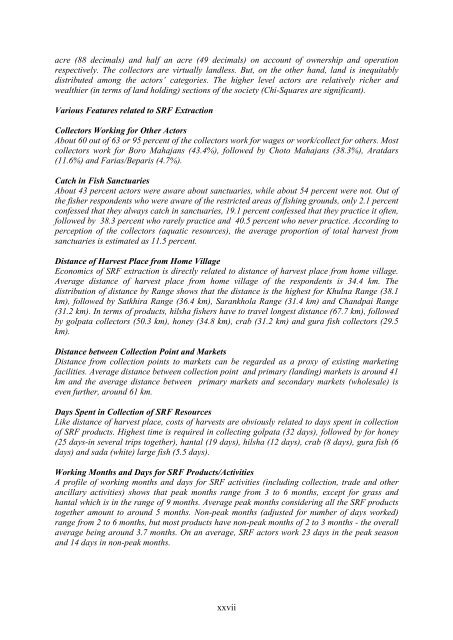INTEGRATED PROTECTED AREA CO-MANAGEMENT (IPAC) - BIDS
INTEGRATED PROTECTED AREA CO-MANAGEMENT (IPAC) - BIDS
INTEGRATED PROTECTED AREA CO-MANAGEMENT (IPAC) - BIDS
You also want an ePaper? Increase the reach of your titles
YUMPU automatically turns print PDFs into web optimized ePapers that Google loves.
acre (88 decimals) and half an acre (49 decimals) on account of ownership and operation<br />
respectively. The collectors are virtually landless. But, on the other hand, land is inequitably<br />
distributed among the actors’ categories. The higher level actors are relatively richer and<br />
wealthier (in terms of land holding) sections of the society (Chi-Squares are significant).<br />
Various Features related to SRF Extraction<br />
Collectors Working for Other Actors<br />
About 60 out of 63 or 95 percent of the collectors work for wages or work/collect for others. Most<br />
collectors work for Boro Mahajans (43.4%), followed by Choto Mahajans (38.3%), Aratdars<br />
(11.6%) and Farias/Beparis (4.7%).<br />
Catch in Fish Sanctuaries<br />
About 43 percent actors were aware about sanctuaries, while about 54 percent were not. Out of<br />
the fisher respondents who were aware of the restricted areas of fishing grounds, only 2.1 percent<br />
confessed that they always catch in sanctuaries, 19.1 percent confessed that they practice it often,<br />
followed by 38.3 percent who rarely practice and 40.5 percent who never practice. According to<br />
perception of the collectors (aquatic resources), the average proportion of total harvest from<br />
sanctuaries is estimated as 11.5 percent.<br />
Distance of Harvest Place from Home Village<br />
Economics of SRF extraction is directly related to distance of harvest place from home village.<br />
Average distance of harvest place from home village of the respondents is 34.4 km. The<br />
distribution of distance by Range shows that the distance is the highest for Khulna Range (38.1<br />
km), followed by Satkhira Range (36.4 km), Sarankhola Range (31.4 km) and Chandpai Range<br />
(31.2 km). In terms of products, hilsha fishers have to travel longest distance (67.7 km), followed<br />
by golpata collectors (50.3 km), honey (34.8 km), crab (31.2 km) and gura fish collectors (29.5<br />
km).<br />
Distance between Collection Point and Markets<br />
Distance from collection points to markets can be regarded as a proxy of existing marketing<br />
facilities. Average distance between collection point and primary (landing) markets is around 41<br />
km and the average distance between primary markets and secondary markets (wholesale) is<br />
even further, around 61 km.<br />
Days Spent in Collection of SRF Resources<br />
Like distance of harvest place, costs of harvests are obviously related to days spent in collection<br />
of SRF products. Highest time is required in collecting golpata (32 days), followed by for honey<br />
(25 days-in several trips together), hantal (19 days), hilsha (12 days), crab (8 days), gura fish (6<br />
days) and sada (white) large fish (5.5 days).<br />
Working Months and Days for SRF Products/Activities<br />
A profile of working months and days for SRF activities (including collection, trade and other<br />
ancillary activities) shows that peak months range from 3 to 6 months, except for grass and<br />
hantal which is in the range of 9 months. Average peak months considering all the SRF products<br />
together amount to around 5 months. Non-peak months (adjusted for number of days worked)<br />
range from 2 to 6 months, but most products have non-peak months of 2 to 3 months - the overall<br />
average being around 3.7 months. On an average, SRF actors work 23 days in the peak season<br />
and 14 days in non-peak months.<br />
xxvii














